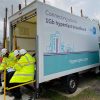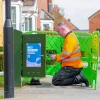Government Changes UK Gigabit Broadband Voucher Rules

The Government has just approved some changes to the rules and eligibility criteria for both their £67m Gigabit Broadband Voucher Scheme (GBVS) and the £200m Rural Gigabit Connectivity (RGC) programme, which effectively harmonises both schemes and helps the funding get to the right areas.
Just to recap. The GBVS is the oldest of the two schemes and offers up to £2,500 to help businesses and homes gain access to a 1Gbps capable broadband ISP connection (homes can only get £500 and up to 10 homes can participate for every 1 SME). Meanwhile the RGC launched last year and offers up to £3,500 for small businesses and up to £1,500 for residents.
The greater value(s) of the RGC vouchers were intended to reflect the higher cost of deployment in rural areas. Crucially the RGC scheme does NOT include a business requirement like GBVS (i.e. homes can easily get a voucher), but like GBVS it is still possible to aggregate the vouchers in order to help tackle larger deployments.
Advertisement
Since then the Government has set aside £5bn to fuel their new ambition of deploying “gigabit-capable” broadband networks to cover the whole of the United Kingdom by around 2025 (here), albeit with a focus on the final 20% of hardest to reach premises. In response to that, and other issues, the Department for Digital, Culture, Media & Sport (DCMS) has now made a few changes to align this policy with their GBVS and RGC programmes.
GBVS Changes and Funding
As most people know the GBVS has been very popular and is thus running low on funding. At the time of writing we understand that £58m of the £67m has now been committed (reflecting a total of 58,000 requested vouchers), although this falls to £39m when only looking at the final result of live connections (17,000).
Meanwhile a further £20m worth of projects are already in the pipeline but the vouchers themselves continue to be issued on a first come, first served basis until the money is exhausted. However the GBVS eligibility criteria is due to change on 31st January 2020 (ISPs will start to be informed about this from today), which means that areas where 100Mbps or faster services are available will no longer be eligible (e.g. areas with Virgin Media, G.fast or altnet ultrafast networks etc.).
At this late stage the change isn’t all that important, although it may slightly prolong the scheme by effectively removing dense urban areas from scope (giving it more of a rural outside-in focus to align with Government thinking). Pre Registered Packages (PRP) that are already in progress via the old criteria can still be submitted up to 14th February, provided the vouchers themselves are then requested by 29th May 2020.
Advertisement
RGC Changes
The RGC is a younger scheme and as such the total vouchers requested so far are just 4,000 (worth £9m), with about 403 vouchers (worth £825,000) already being turned into live connections. Despite this some alternative network (altnet) ISPs have run into problems with the current minimum speed criteria of 30Mbps, which often means they can’t build gigabit-speed FTTP in rural areas when a slower “superfast” FTTC network is present.
Until now some operators have got around this problem by mixing GBVS and RGC vouchers, but with GBVS coming to an end and the Government switching their focus to “gigabit” speed connectivity then it has become necessary to harmonise both voucher schemes to support the new focus (the DCMS / LFFN team have long intended to do this).
In short, the RGC eligibility criteria is today changing so that rural areas where “ultrafast” speed (>=100Mbps) is not available are now eligible (i.e. most rural premises). Now operators don’t have to worry about doing a patch-work build to avoid slower FTTC areas, or mixing voucher schemes, and can instead focus on tackling entire villages with FTTP etc.
The move also avoids an awkward debate on the questionable accuracy of Ofcom’s Connected Nations speed data, as well as the usual advertised ISP speed vs. actual speeds problem that some networks have, by setting a higher bar.
Advertisement
Going forward it’s been suggested that the eligibility criteria may simply adopt a “final 20%” style definition to align with the future £5bn programme, but they’ll probably want to see what impact today’s change has first. On the other hand the RGC scheme is only due to run until March 2021 and so we may see such a change occurring this year.
Mark is a professional technology writer, IT consultant and computer engineer from Dorset (England), he also founded ISPreview in 1999 and enjoys analysing the latest telecoms and broadband developments. Find me on X (Twitter), Mastodon, Facebook, BlueSky, Threads.net and Linkedin.
« SSE Broadband and Energy Customers Now Owned by Ovo UK
O2 UK Follows Vodafone into Testing an OpenRAN Network »























































“areas where 100Mbps or faster services are available will no longer be eligible (e.g. areas with Virgin Media, G.fast or altnet ultrafast networks etc.)”
Hmmme my area gets Gfast.
My neighbour next to the PCP/Pod can’t get it because of the copper wire arrangements. However a large chunk of the street can get it.
Does this now mean that my neighbour is ineligible for an intervention because the ‘area’ can get it.
Rural focus is all very well but urban not spots are all over the place.
the experts said this would happen with gfarce. And so it has. and so no, your friend will never be helped until the whole street is done properly with fibre.
I cannot understand why government took the wrong advice and didn’t listen to the clever folk instead of OR snake oil salesmen.
@CC – another of your references to the late Bill Murphy.
Classic Chris- don’t let the truth get in the way of a good story.
In this case, not a single g.fast deployment has been funded by govt so this “advice” doesn’t exist.
“My neighbour next to the PCP/Pod can’t get it because of the copper wire arrangements. However a large chunk of the street can get it.”
Assuming you could find a solution for the voucher and can show that G.fast or better wasn’t already possible (not that tricky with the checkers) then I think LFFN/DCMS would probably approve the voucher. Difficulty is in finding an affordable solution for a single home.
I don’t recall any experts claiming this would happen with G.fast and, regardless, it hasn’t.
If G.fast not available due to distance from PCP intervention still an option.
Not a fan of that product, the deployment was a time wasting, box ticking exercise but lost on this criticism of it.
@CC
Please try and restrain yourself.
I was trying to make a real valid point so that we could start a thoughtful debate or put solutions out there for others to see.
Simply posting “superfarce” and “gfarce” to everything doesn’t help get the message across either to those bereft of connectivity or to those in government who do look at this site what the problems and solutions are.
Forums like this can, when the debate is thoughtful, have a large impact on thinking. If we all just post unthinking material then nobody takes the debate seriously.
As you will know from my previous posts, I’m no lover of GFast either but I do have it connected to my home.
Facts… do not be naughty.. orders issued, orders followed…challenges made… more challenges made… record is amended,deferrals increased and on we go..96%+ delivered ..97% contracted .. 98%+ in the pending bucket with plenty of petrol in the tank.
17% of 6m most rural not delivered (EFRA) is shameful but it is fixable. 17% of SME (Connected nations) not being able to access superfast is more concerning, that takes quite a bit of planning to claim what is claimed against this reality.
Chris and Ba4n have showed how d-able fibre roll-out is and so the benchmark set by Ba4n is an important part of the UK story.
‘Chris and Ba4n have showed how d-able fibre roll-out is and so the benchmark set by Ba4n is an important part of the UK story.’
You are joking, right? A grand or more in cash per premises passed, free wayleaves to permit avoidance of hard digging most of the time, volunteer labour, co-operative non-profit, crowd funding and government subsidy to produce fewer premises ever than Openreach do in a week is a benchmark showing how doable this is?
Are you out of your mind?
This showed how hard these people had to work, how much generosity, good-will and help was needed and how much adversity they had to work through. Especially the good-will. Without that this would not work – a built was stuck over a demand for a few hundred quid to site a cabinet and you think this is a sustainable, scalable benchmark showing how doable it is?
It’s actually quite insulting to them suggesting that what they did is so doable.
I know I said I wouldn’t respond to you again but felt like the cab I am in and taken a wrong turn and put me in the twilight zone, so while I was here I thought I’d talk to the local resident.
If you want how doable this is in the real world outside of most of the above advantages ask Gigaclear how they are doing and how much it’s costing them per premises passed.
Qualification should be based on what is available to the address, rather than what is available in the wider postcode area.
CarlT – you miss the point. FTTC was projected to cost the UK £5bn in 2009. It is closer to £3bn. – (£1,3bn from BT – £1.6bn from Gov – BT may pay it all back) The propaganda on cost continues on FTTP although it has lessened. BT have indicated they can reach 90% FTTP but in 2010 it was only 66% FTTC. This is quite a change in perspective.
By Ba4n being present they can at least set a low benchmark for a ‘new’ build deep in rural. Gigaclear is a poor example as they need to start from scratch, no poles to overlay, no duct to repair, no national core, no wholesale systems.
Perhaps you’d prefer that any contract bidder was to under estimate costs.
The bulk of what you pontificate on is your unwlllingness to accept that projections are different from an invoice for work done.
BDUK contract was different to many public civil projects in that any extra costs for meeting the contract target were to fall upon the contract winner. This was known when bids were being put together, and thus taking a safe view (from the view point of contract winner) and expecting to deliver the required volume for less money was always expected.
Mike – you have pulled that £1.3 billion figure from your hindmost.
That’s the CapEx spend for the 2/3rds of the country that was covered commercially.
You’ve ignored BT’s capital contributions to any BDUK projects and ignored incremental operational costs full-stop. Again.
None of this has anything to do with B4RN. A group you so admire you can’t even get their name right – Broadband 4 the Rural North.
B4RN have nothing to do with how simple or otherwise it would be for any commercial operator to reach the most rural areas. The £4k per premises for the last 10% may be accurate, it may not.
These numbers are produced by real analysts, professionals with extensive experience, based on available data at the time. Deployment method changes have substantially cut the costs of Openreach FTTP which is great. The costs will continue to change as time goes on.
Your mind may be set in aspic. Thankfully the rest of the world moves on and hopefully it’s to the benefit of us all.
CarlT .. £1.3bn is within the Ofcom WLA 2017 modelling, it is in the annexes. The BDUK capex from BT is yet to be published. Operational cost and capitalisation policies are a separate to estimating capex requirements.
Andrew .. NAO 2015 found costs were inflated by 38%.. something BT denied specifically in 2013 PAC.. Every single project has reported ‘savings and efficiencies’. These are nothing more than the inflated costs subjected to the ongoing scrutiny – the BT capital contributions to allowable is on top. There is more to come.
If thinkbroadband can count BDUK cabs, then it can count the BT cabs and calculate how much cheaper these might be. It is not hard.
So a model from 2017 when BDUK contracts were still delivering in volume and probably based on data from 2016. Source of the costing used in the model?
2013 PAC – well they’d only just started delivering, so things like efficiencies were probably not obvious, e.g. less time taken and price of kit may have dropped over time
2015 seems to have identified some savings, but again only 2 – 3 years into contracts, and those efficiencies as well as gainshre are why mini contracts keep on appearing.
You’ve had me read those reports again before and unable to find definitive costs of what the total FTTC roll-out cost, and you cannot since they are still adding the odd cabinet and expanding via line cards or additional cabinets.
One can arrive at estimates and ball park figures but these need a raft of caveats.
Andrew, WPQ on the capital now stretch through to 2019, and you can go through EFTA report.
Ofcom do pinpoint 49,000 first time commercial cabs, which is quite small, and BT did stop doing FTTP so all of that can come off. The fair bet analysis was restricted to £1bn because there was no second billion to analyse.
I guess Openreach could have been separated for investing more than they said.
LOL @ NGA
You obviously have not had your infamous slide rule over the ‘Ba4n’ accounts.
They are far, far away from the bushiness plan. Even further away than Ms Conder is from reality.
How are the B4RN accounts?
For clarity:
“RGC is complementing other BDUK programmes, such as Superfast Broadband and Local Full Fibre Networks. However, the RGC programme will not overlap with areas where a gigabit-capable solution will be delivered through these existing or commercial interventions”
GBVS “Rural premises with broadband speeds of less than 30Mbps can use vouchers worth up to £3,500 for each SME and up to £1,500 per residential premise”
So it only really applies in specific situations and much of the RGC is available to LAs/BDUK to create “hubs” and specific uses such as rural primary schools.
The forthcoming USO (still no news on how funded?) will only apply to those under 10Mb in very rural. Most (particularly semi rural) will be offered 4G with any subsidy going to aerials. But all this is within the control of BT. We already have 52% with ultra, rural help coming for the final 20% which leaves 30% completely left behind for the foreseeable.
Therefore the DCMS and Ofcom need to outline how Ultra/Giga will be achieved and how to address excluded homes (Not just in OR or VM but Cityfibre and other Altnet areas).
Sorry 28% (updated VM figure)
Meadmodj .. Ofcom B-USO consultations about consultations, states their will be a further consultation on the working of the fund when BT makes the first application. It needed kicking down the road, something Ofcom are very good at. It will be interesting if BT attempt to make a request before 2025 given works outstanding, pending.
On vouchers, as long as all the passive infrastructure put in is re-usable for the purposes of supporting critical services then vouchers should not do much damage, as long it does not prevent another 500-600k English rural properties being contracted for an eventual upgrade and this is not considered a substitute then it will be all right.
It’s the uncertainty of it all and based on past experience I am not expecting any more clarity. We still don’t know what the £5b consists of as they may have already deducted vouchers, BDUK and BT monies owed etc so the figure may be a lot less. It’s also not going to come upfront but as usual in bureaucratic dribbles.
Whilst the real goal is of course FTTP for all and Giga+ capability (the long term strategic investment) what the country/economy actually needs is Ultra products by 2025 then Giga by around 2033.
CC continues to have a go at FTTC and we know the history but it did lift the vast majority of premises to a reasonable broadband speed in the shortest period of time. Looking at what is coming is Giga for some (of which many will still contract slower products) and a long long wait for others with 4G/5G undermining FTTP investment.
The £5bn is spurious (less spurious than Labours proposals) and is not evidence based as it is not reconciled against the current work. The Gov does not need a sunset date for PSTN if BDUK can be concluded with 40k cabinets and 1m FTTP (480k completed + 250k contracted +NI +R100) at the rural edge.
‘The Gov does not need a sunset date for PSTN if BDUK can be concluded with 40k cabinets and 1m FTTP (480k completed + 250k contracted +NI +R100) at the rural edge.’
We need a sunset date for PSTN as without it the commercial case for FTTP is harmed.
A key part of the commercial business case for FTTP is being able to switch off the PSTN. It is that which permits Openreach to build to 50% by 2025 – PSTN closure means 60%+ savings in operational costs.
It also means less taxpayer subsidy is required as more of the country is commercially viable.
CarlT .. BT need a sunset date, the Gov can now take its time. BT should be permitted to glean upsides from all the operational cost savings from any ‘early’ conversion. Industry can agree ~2040. 2025 has made with zero understanding of the issues. IMHO Gov could use much of this £5bn ( e.g. lower spectrum costs,) to do support 5g eco-system, convergence and how 1m radios will interact within a 1km of urban space. I think 2,000 radio engineers /planners will be needed.
The incremental overlay of FTTP (for BT) on top the 1200 Ho’s and 40k subsidised cabs is c£13-£15bn well within the Openreach envelopes over 15-20 years. Getting 1m FTTP at the rural edge from the existing activity will be a lasting achievement.
I do wonder if the voucher scheme works if you can get FTTP-On-Demand, as technically a service is there if you wish to pay for it (but I guess that’s what the voucher scheme is there for?).
Personally I have tried to engage with my local Parish Council about sorting out a Community Fibre Partnership (live in a village in Hampshire) but they said “we already have fibre” (we have FTTC) and have emailed my local ward Councillor twice and never bothered to contact me back. I guess the only way is to sort out a CFP myself.
Almost every address can get Full Fibre in the UK today if you were to accept Fibre on Demand as already supplied, since by that premise you would have to accept that Ethernet/Leased Lines is available everywhere if your pocket is deep enough.
So FoD should remain eligible for use with vouchers.
How did you ‘engage’ with the parish council? In my experience they are normally run by older retired folk that don’t understand the terminology or technology.
You may need to go to a local meeting and explain to them a little more about the advantages of having FTTP available in the community – many will be perfectly happy with their FTTC connection but I am sure many in the community are suffering from issues or low speeds due to distance?
A local village to me (Acol Kent) has FTTC available where half the village can get 20Mbit+ speeds and the other half struggle due to distance and poor quality lines. They are going through the Community Fibre Partnership program currently and should have a build date this year.
@JamesP – I emailed the Parish Council a couple of times. They forwarded my questions onto their “IT Guy” (who turns out to be the retired IT engineer who runs the pensioners IT drop-in sessions in the village hall) and he effectively dismissed what I said, stating we “already have fibre in the village”. Personally I get “OK” fttc (60mbit/20mbits) but it’s a linear settlement and the further up the road you go, the slower it gets and quite quickly too.
Barney – nationwide FoD was publicly announced by then CEO Openreach in May 2015… It was somewhat of a false conversion compared to the more Damascene conversion by the subsequent CEO of Openreach.
The challenge with this early FoD is that the expectation was for FTTP GON extensions -beyond ~1200m of the cabinet while the wholesale market product was designed around a private circuit presentation.
You are likely still to go through BT/BDUK/community fibre to get a GPON extension and this should be possible. Double check if an alt-net is using the vouchers to subsidise a product from a provate circuit stable.
The issue now is they are looking at download speeds and not upload speeds to gauge eligibility. The £2500 voucher scheme was typically for small businesses or home workers, and these are customers Virgin do not really exist to target, both in their customer support, hardware (needing tunnels for business traffic and to get static IPs gives rise to problems) and upload speeds being low (currently showing up to 35Mbps on their business package).
The voucher scheme therefore could pay towards something more business targeted, either a leased line, or FTTP on Demand and services from a more business oriented ISP, with reliability of fibre and potential faster speeds in the future.
I guess the main issue is they are just running out of money and want it to last a bit longer so reducing those eligible to claim is one way of doing that. However just because you can get Virgin Media, doesn’t mean you wouldn’t be looking for a better solution.
Whilst I agree that we need to assist specific businesses there is the counter argument that many businesses can get higher speeds it’s they simply don’t want to pay for it. Unlike consumers they can put their costs against tax and net VAT. I also have never had much sympathy for a digital based company moving to lower cost accommodation in an old wood yard or quarry and then moaning about broadband, they should consider that before moving.
A VM VROOM 500 (or multiples of) can support a lot of users so thats 52% of the premises and proportionally probably much higher for business premises.
Upload I think is still over played. When we used to have to support remote servers on 1200k modems we kept to simple remote control program and line command. Ok things have moved on but my wife has recently started to do some work for a charity and to address GDPR and other things they use remote desktops on Windows Server 2012. She has the full monty of numerous business apps, Microsoft 365/Outlook Client plus fast internet and all data is held centrally encrypted and backed up. The bandwidth requirement from home is probably less than my SONOS. Even if you were using 4K and fast moving content it would be hard to see an issue. Cloud working has its pros and cons but most of the cons I see are due to using it inappropriately.
I agree businesses do need an effective and reliable broadband which probably above 20Mb up will more than meet the needs of a small 1-20 company. If their business is really heavily data dependant then they really should be using a leased line.
If there is to be any public money it needs to go to businesses that do not have a realistic choice and the lack of sufficient speed has not been self imposed.
@Meadmoj
I’d challenge you to run a business doing any kind of BIM modelling on a 20mb/s upstream.
Why should an SME spend a big % of it money on a leased line?
It is a barrier to productivity and the digital divide is wider.
People like Hyperoptic and CF get this and provide perfectly usable solutions at an approachable price.
I suspect VM will offer higher uploads on their FTTP to businesses maybe dropping the RFoG for that segment: pure speculation on my part. OR are trialling symmetric for business as a half way house to leased.
Some businesses have a regulatory obligation to have clean snapshots of certain data. No snapshots – no compliance – no business.
Time spent working around poor connectivity is a productivity sink.
@A_Builder
BIM sounds a little specialist and my comments were meant to be regarding the average business. But looking at it there is no reason why it would not be possible to get BIM to run on a hosted desktop and if a business has employees at different locations centralised data would be better solution for them anyway alleviating large files having to move about.
“Why should an SME spend a big % of it money on a leased line?”. Agree but that is more an issue about current availability and relative cost. Restricted vouchers only benefit a few and those able to utilise them (criteria/provider/contribution). That is my issue that there is no equitable strategy to uplift broadband speeds for UK businesses overall with some destined to wait years.
All I was saying is that in the meantime a good proportion of businesses could address their issues by minimising their bandwidth requirement and a high percentage already have availability to higher speed products to make that even more effective.
@Meadmodj, you might think upload speed over played, but you are just going by your own use case. Don’t forget there are millions of small businesses/sole traders out there of varying sizes, in varying locations, with varying profits and loss, and they aren’t all you! What you think they need is neither here nor there. Also realise that those small businesses may not have any option but to move to cheaper premises when economic conditions dictate.
Yes a business might need a leased line to grow their business and be competitive, and that is exactly what the vouchers were helping with. Now they will not be given if Virgin Media is available, but Virgin Media is not a lease line.
I only gave my wife’s use as an example. But to reiterate it resilient/reliable on mobile and even public wifi (most of her business meetings are in a cafe or garden centre as well as addressing wider issues such as GDPR.
Yes I completely agree that not all business are the same, all I am pointing out is there are options from small businesses using basic cloud applications {Google Apps etc) to hosted desktops. They don’t all have to move data back and forth over broadband only key strokes and mouse movement and 2 Mb down is sufficient for an average MS Windows screen. The more complex the app, resolution, % refresh and the number of users obviously requires more but you have to have a particularly special business requirement to exhaust ultra products.
Hosted Desktops can be as basic or as advanced depending on the requirement. No they won’t suite everybody but if my business was suffering from slow broadband and had no prospect of resolution short term I would hope their IT Support should make them aware of the possible.
I think more the point is that if there was a minimum upload requirement for business it would force VM to do something different with the newer all glass bits of their network where an upgrade of proper business services are very possible.
VM are now the odd one out in that even OR are trialling symmetric and Im struggling to think of anyone else who is very asymmetric and most of the bigger Alt Nets offer fully symmetrical services.
At the end of the day VM may be forced to do something by businesses walking from there services to Alt Nets or OR services. Where there is over build there is risk of this.
At the end of the day it comes down to money but also to service differentiation. As virtually everyone else can offer faster upstream expect advertising to focus on this and on latency as this is then fair game as the differences will be measurable and quantifiable.
*their
can’t type on my phone!
It may be that for both OR and VM it is not just a technical issue but a commercial one. They probably still seek to differentiate consumer from business and also protect their P2P revenues. They probably also need to keep the products they support to be as wide as possible rather than location specific. But as you say Altnets are offering symmetrical services so the pressure on them will grow.
@MeadMoj
OR are doing symmetric trials.
Therefore OR will, once it is released, clean up in overlapped areas on Business connections, if the price is right, where there is no Alt Net. That is a strong commercial driver as businesses pay a lot more than consumers.
VM will then have to respond or exit the business market.
As someone with a 20mbit fttc connection (it was 30 when originally deployed 5 years ago) are there any providers I can use with this sort of voucher or am I screwed over living in a smallish town bt forgot? (It’s crazy i live in a small town just miles from Southampton)
Hampshire CC according to BDUK reports are still owed upgrades to another 7k premises from existing contracts, and have the monies to contract for more. Worth contacting the project office and attempt to you village on the list.
NGA for all- The problem is I live in a town of 10000+. I’m supposed to be able to get just over 30mbit according to the checkers so I’m probably considered ‘serviced’…
Philip, that’s problematic, but a GPON extension might be possible if there 8 to 10 of you.
I enquired with Ofcom if this new funding can be used in combination with USO for those of us in areas with the poorest connections or no connections at all. Ofcom confirms this wouldn’t be for them to decide.
I am hoping the various schemes can be stacked to unlock higher levels of funding, given that even under the USO coming in a couple of months, our area still wouldn’t qualify as we would greatly exceed the cost threshold. I am really hoping that the shortfall in funding can be made up using the alternate schemes.
Nobody seems to be able to confirm if this is possible
The issue is less about money and more about resource to do the work. Current contracted work is taking 2+ years to schedule and complete.
Ofcom will wait for BT to make a B-USO funding application before they consult on how the funding mechanism will work in practice. OLO will want detailed evidence that all the BT commitments (clawback and capital) are fully reconciled before they are expected to contribute to upgrading BT’s network, the latter as the legislation is written includes Greater London.
I’m going to look into this – being under a mile from Barnsley city centre and not being able to get ADSL which the neighbours in the next road can get Virgin really stings.
Am in a similar position, where my local provider appears to have made it available and accessible to all those in the village (digging up roads) but when I enquired I was told that (a) I should get more neighbors on my side of the street involved, then (b) the engineer who visited wanted to run the cable underground, then overground pinned onto a neighbors fence (who he wants me to speak with), then onto my house.
Its a real pain!